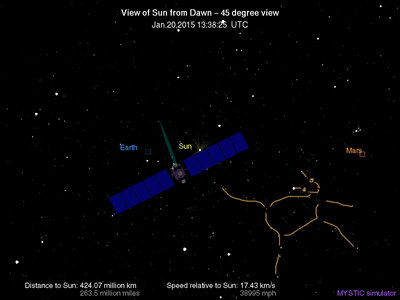by epitalon » Tue Jan 20, 2015 1:28 pm
hello,
my post is relatively unrelated to Ceres, rather loosely related to Dawn spacecraft.
I found on Dawn website a simulated view of our inner solar system from Dawn, in which some stars from Orion and Taurus constellations are depicted.
See
http://dawn.jpl.nasa.gov/mission/live_shots.asp
In this simulated view, the constellations look as seen from human eye, contrarily to some pictures obtained by photography.
This allows me to point to some idea that I had in mind for a while : constellation names come really from their resemblance with natural objects.
It is not so evident from today's standard partition of the sky in constellations.
The simulated view in question allows me to show you how I see a "bull" in the Taurus constellation. Rather, I can imagine easily a dancing calf, its queue pointed up, its two fore legs streched forward, its two eyes and its two horns, Aldebaran being at the tip of one of it.
In the attached picture, I outline the body, two fore and one hind legs, horns, eyes, nose and queue.
Please, let me know if what I outlined is a standard "explanation" of Taurus or something rather fancyful !
Jean-Marie Epitalon, just an admirer of sky
- Attachments
-

- Dancing calf outlined in simulated view from Dawn
hello,
my post is relatively unrelated to Ceres, rather loosely related to Dawn spacecraft.
I found on Dawn website a simulated view of our inner solar system from Dawn, in which some stars from Orion and Taurus constellations are depicted.
See http://dawn.jpl.nasa.gov/mission/live_shots.asp
In this simulated view, the constellations look as seen from human eye, contrarily to some pictures obtained by photography.
This allows me to point to some idea that I had in mind for a while : constellation names come really from their resemblance with natural objects.
It is not so evident from today's standard partition of the sky in constellations.
The simulated view in question allows me to show you how I see a "bull" in the Taurus constellation. Rather, I can imagine easily a dancing calf, its queue pointed up, its two fore legs streched forward, its two eyes and its two horns, Aldebaran being at the tip of one of it.
In the attached picture, I outline the body, two fore and one hind legs, horns, eyes, nose and queue.
Please, let me know if what I outlined is a standard "explanation" of Taurus or something rather fancyful !
Jean-Marie Epitalon, just an admirer of sky